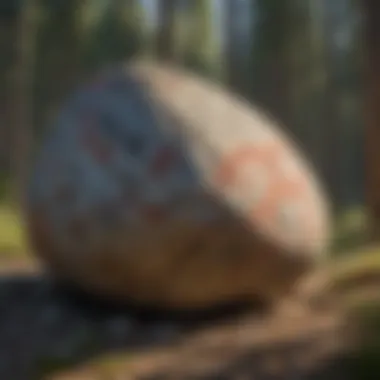Exploring Idaho's Historical Sites: A Journey Through Time


Intro
Idaho's historical sites stand as testaments to its rich and diverse heritage. Each site encapsulates a moment in time, providing a glimpse into the lives of those who once inhabited this beautiful state. Through examining these locations, one can appreciate the intricate narratives that have shaped Idaho’s cultural landscape. This article aims to uncover the significance of these sites, from ancient indigenous settlements to the vestiges of settler colonialism.
The state of Idaho unfolds a story of resilience and transformation, influenced by various cultures and historical phenomena. The discussion centers on key themes, including indigenous heritages, the impact of colonial expansion, and the pioneering spirit that characterized the region. By exploring these elements, readers will deepen their understanding of Idaho's historical legacy and its ongoing relevance today.
As we delve into the narrative of Idaho's historical sites, we will focus on each location's broader context and significance in a larger historical framework. The aim is to inspire a sense of awareness and appreciation for Idaho's past, contributing to the enriching discourse surrounding our nation’s diverse histories.
Preamble to Idaho's Historical Significance
Idaho's historical significance is a complex narrative that threads through various epochs and cultures. This article aims to illuminate these layers by exploring the myriad of historical sites that serve as tangible reminders of the past. Understanding this significance is essential for recognizing how history shapes present identities and influences future developments. Each historical site represents a piece of the state's narrative, essential for interpreting Idaho's unique character.
The exploration of Idaho's historical landscape is more than mere tourism. It fosters a connection to history, promoting awareness and appreciation of the state’s rich heritage. By engaging with historical sites, not only do we discover the events that have shaped Idaho, but we also uncover the stories of the people who lived through those times.
Understanding Idaho's Historical Landscape
Idaho’s historical landscape is diverse, encapsulating various cultures and significant events. Early indigenous populations, such as the Nez Perce and Shoshone, established vibrant societies long before European settlement. This timeline introduces us to a rich cultural tapestry of traditions, languages, and practices that continue to influence contemporary Idahoans. The arrival of European settlers brought significant changes, including new economic opportunities and cultural exchanges.
Recent developments, such as increased recognition of indigenous rights and heritage, reshape how we view historical narratives. This evolution prompts discussions about the preservation of these narratives against the backdrop of modernity. Thus, Idaho's historical landscape serves as a dialogue between the past and present, emphasizing the importance of understanding history in context.
Role of Historical Sites in Education
Historical sites in Idaho play a crucial role in education, acting as open-air classrooms. They provide direct experiences that go beyond traditional learning. Visiting places like the Oregon Trail or Fort Boisé helps individuals connect with historical context vividly and tangibly.
Educational programs at many historical sites offer workshops, guided tours, and interactive exhibits. These initiatives not only engage students but also foster a deeper appreciation for the state’s rich history. Through community collaborations, various organizations work to enhance public understanding of historical significance.
"The value of historical sites lies not only in their preservation but also in their capacity to educate and inspire future generations."
In an era where digital learning dominates, experiencing history firsthand at these sites can rekindle interest in local heritage. Educational institutions, when paired with historical sites, can build effective curricula that promote critical thinking and historical inquiry. This approach is essential for instilling a sense of identity and community pride among students.
Understanding Idaho's historical significance is vital for ensuring that this legacy is preserved and appreciated for generations to come.
Key Historical Periods of Idaho
Understanding the key historical periods of Idaho is crucial for comprehending the state's unique identity. This section will delve into significant eras that have shaped Idaho's cultural landscape. Each period contributes to the rich narrative of the region, emphasizing the journey from its earliest inhabitants to modern-day Idaho.
Prehistoric Era and Indigenous Cultures
The Prehistoric Era marks a pivotal time in Idaho's history. Long before European settlers arrived, diverse indigenous cultures thrived in the region. Tribes such as the Shoshone, Nez Perce, and Coeur d'Alene established communities that revealed deep connections to the land.
These populations engaged in hunting, fishing, and gathering, utilizing local resources sustainably. Artifacts such as pottery, trade tools, and rock art provide insights into their way of life. Moreover, spiritual beliefs and storytelling were integral to their cultures, forming a foundation of values that persist today.
Recognizing the significance of these indigenous cultures is vital. They offer a lens through which we can appreciate the early human connection with the environment.
The Arrival of European Settlers
The arrival of European settlers in the mid-19th century introduced profound changes to Idaho's landscape and its indigenous inhabitants. Notable events include the Lewis and Clark Expedition, which paved the way for future exploration. Following that was the influx of settlers drawn by the promise of land and opportunity, particularly during the Oregon Trail's peak.
As settlers poured in, they established farms and communities. Conflicts arose between settlers and indigenous tribes over land and resources. The resulting transformation altered the demographic and cultural fabric of the region, often at a heavy cost to the native populations.


This era is characterized by both opportunity and turmoil, marking a significant shift in Idaho's historical trajectory.
Statehood and the Gold Rush
The journey to statehood in 1890 and the Gold Rush profoundly influenced Idaho's expansion and development. The discovery of gold in the late 1860s attracted thousands, creating boomtowns such as Boise and IDahofalls. This influx of people spurred economic growth and infrastructure development.
Statehood cemented Idaho's place in the Union. It became essential for political representation and governance. As people flooded in, conflicts and tensions often flared, particularly surrounding resource management and land rights.
The experiences of this period are rich in complexity. They illustrate how ambition and resource wealth can drive growth, yet also lead to significant social and environmental challenges.
"Idaho’s history highlights a constant interplay between growth and the preservation of cultural identities that continue to shape the state today."
Each of these historical periods provides valuable lessons about the interactions of culture, conflict, and change. Recognizing these elements can deepen our understanding of Idaho as a whole.
Major Historical Sites in Idaho
Idaho is home to a range of major historical sites that are crucial to understanding the state's heritage. These sites not only represent significant events but also illustrate the transformations that have shaped Idaho through the centuries. From ancient trails that facilitated migration to military forts that played strategic roles, these locations serve as vivid reminders of Idaho's multifaceted past. Exploring these sites offers insights into the social, cultural, and economic developments that have defined the state.
The Oregon Trail: A Pioneering Route
The Oregon Trail is perhaps one of the most recognized routes in American history. Stretching over 2,000 miles, this trail was primarily used during the 1840s and 1850s and allowed thousands of settlers to migrate westward. Idaho's segment of the trail was vital for travelers seeking new opportunities in the Pacific Northwest. Along the way, key landmarks such as the Boise River and the ancient lava flows provided both challenges and resources for pioneers.
Walking in the footsteps of these early settlers, one can appreciate the sheer determination and resilience that characterized this period. The Oregon Trail is not just a path; it represents hope, courage, and the pursuit of a better life. This historical route continues to educate visitors on the settlers' journeys, connecting them with the challenges of the past.
Fort Boisé: Military and Trade Hub
Fort Boisé served as a significant military post during the 19th century. Established in 1834, it was crucial for the protection of traders in the area and provided a strategic foothold for the United States Army. The fort became a focal point for trade, attracting various groups that sought to engage in commerce.
Understanding Fort Boisé’s role helps illuminate interactions among indigenous peoples, traders, and settlers. The site reflects the blending of cultures and the complexities of power dynamics during a period of expansion.
Moreover, Fort Boisé presents an opportunity for deeper exploration into military strategies and community interactions of that time. It stands as a testament to Idaho's explosive growth and changing landscape.
The Idaho State Historical Society
The Idaho State Historical Society plays a central role in preserving Idaho's rich history. This organization is responsible for collecting, preserving, and interpreting artifacts and documents that chronicle the state's past. The society operates several museums and historical sites, fostering public engagement through educational programs and exhibits.
Engaging with the Idaho State Historical Society allows visitors to gain a more nuanced understanding of Idaho's diverse narratives. From ancient indigenous traditions to modern-day issues, the society emphasizes the importance of remembering and learning from the past.
In summary, the major historical sites in Idaho not only highlight key events but also present opportunities for education and reflection. They invite visitors to draw connections between the past and present, enriching our understanding of Idaho’s heritage.
Cultural Heritage Sites and Their Importance
Cultural heritage sites serve as tangible connections to the past, telling stories of a region's unique history. In Idaho, these sites are not just remnants of bygone eras but vital components of education, tourism, and community identity. They connect people to their roots, allowing for a deeper understanding of the socio-economic and cultural developments that have taken place over generations.
Understanding the significance of cultural heritage sites lies in their ability to preserve the collective memory of a community. They play a crucial role in educating not only the local populations but also visitors about the diverse narratives that define Idaho. By exploring these sites, one can gain insights into the struggles and successes faced by indigenous cultures and settler communities alike.
Indigenous Heritage Sites
Indigenous heritage sites in Idaho encapsulate the deeply rooted histories of Native American tribes. Locations such as the Nez Perce National Historical Park showcase the significant events and cultural practices of the Nez Perce tribe. These sites do not only highlight the historical events but also honor traditions and languages that have been passed down through generations.


The preservation of these sites is imperative for acknowledging the resilience of indigenous peoples facing colonization and marginalization. Educators often use these sites to foster a greater appreciation for the contributions of Native American cultures to Idaho's diverse heritage.
Preservation of Pioneer Settlements
Pioneer settlements are another facet of Idaho's cultural heritage that warrants attention. These sites provide a glimpse into the lives of settlers who ventured into unknown territories, shaping the landscape of Idaho. Restoration efforts at places like the Oregon Trail historic sites help to conserve these narratives while providing educational resources for current and future generations.
The importance of preserving pioneer settlements extends beyond historical value; it fosters a sense of identity among communities. Engaging with their history can help residents of Idaho realize how their ancestors influenced the state's development. This connection encourages a dialogue about heritage and progress, making it essential to invest in preservation initiatives.
The preservation of cultural heritage sites is crucial for fostering community identity and educational outreach, helping to maintain awareness of historical narratives.
In summary, Idaho's cultural heritage sites, from indigenous locations to pioneer settlements, play significant roles in education and community identity. They allow for a rich exploration of the complex narratives that shape Idaho's past, emphasizing the need for their ongoing preservation and promotion.
The Role of Education in Promoting Historical Awareness
Education serves as a bridge between the past and the present, enhancing our understanding of history and its implications. In Idaho, the role of education in promoting historical awareness is crucial for several reasons. First, it cultivates a sense of identity among residents by connecting them to their heritage. Identifying with the stories of past generations fosters pride and responsibility toward preserving historical sites.
Additionally, educational initiatives at historical sites give visitors context and relevance to the experiences of those who came before. They provide a tangible connection to history through hands-on experiences, which often leaves a lasting impression compared to traditional learning methods. The significance of promoting historical awareness cannot be overstated, particularly in the education of younger generations. By teaching them about Idaho’s rich historical narrative, we equip them with the knowledge and appreciation needed to nurture heritage in the future.
Educational Programs at Historical Sites
Educational programs at historical sites are designed to engage audiences, from school children to adults. These programs often include guided tours, workshops, and interactive exhibits that bring history to life.
- Guided Tours: Many historical sites in Idaho offer guided tours led by knowledgeable historians. These tours often highlight key events and figures in Idaho's history, allowing participants to immerse themselves in a specific time period. For instance, the Idaho State Historical Society promotes awareness of significant events through detailed narratives that resonate with visitors.
- Workshops and Activities: Beyond tours, workshops enable deeper learning. Participants can engage in workshops on indigenous crafts or pioneer survival skills, which reveal practical aspects of historical life. This practical engagement nurtures a connection to history that textbooks alone cannot provide.
- Interactive Exhibits: Many historical sites develop interactive exhibits that encourage visitors to learn by doing. These exhibits can include activities such as artifact handling, storytelling sessions, and digital reenactments of historical events. Such experiences are often effective in captivating visitor interest and fostering a deeper emotional connection to the past.
Community Engagement in Historical Preservation
Community engagement is vital for the sustainable preservation of historical sites. It involves involving local residents in the conservation and promotion of their cultural heritage. Community engagement can take many forms.
- Volunteer Programs: Many historical sites enlist volunteers to assist with site maintenance and educational events. This not only helps with conservation efforts but also strengthens ties between the community and its history. By working together, residents gain a sense of ownership of their cultural heritage.
- Awareness Campaigns: Engaging the community through awareness campaigns is essential. These campaigns can include public lectures, social media outreach, and collaborations with schools to raise awareness about the importance of preserving history. Social media platforms like Facebook can serve as effective tools for sharing information and sparking discussions within the community.
- Collaborative Events: Historical sites often host community events that celebrate local history, such as heritage days or festivals. These events can feature local musicians, food vendors, and storytellers. Such celebrations encourage active participation and foster a sense of community pride while providing educational opportunities about the area’s history.
"Education and community engagement in historical preservation are more than just activities; they are essential processes that build respect for our past and responsibility for our future."
In summation, education plays a pivotal role in promoting historical awareness in Idaho. Through tailored educational programs and community engagement strategies, historical sites effectively cultivate a deeper understanding of the state’s rich heritage. This understanding not only contributes to individual identity but also fosters a collective responsibility towards preserving Idaho’s historical narrative.
Modern Challenges in Historical Site Preservation
The preservation of historical sites is vital for maintaining cultural heritage and educating future generations. However, Idaho faces significant challenges that threaten the integrity and survival of these sites. Recognizing these issues is crucial for those invested in historical conservation and education.
Impact of Development on Historical Sites
As urban areas expand and development projects increase, the obstacles to preserving historical sites grow more daunting. Infrastructure projects, such as highways, residential complexes, and commercial buildings, can encroach on or completely destroy sites of historical significance. In Idaho, there have been instances where developments directly impacted Native American heritage sites, leading to the loss of valuable archaeological information and cultural artifacts.
Moreover, the pressure from developers can lead to a neglect of proper preservation methods. Sometimes, historical sites are altered to accommodate modern needs without regard for their original significance. This creates a dilemma between progress and preservation, with local communities often caught in the crossfire.
An example can be found in the development around Boise, which has led to extensive changes in both the landscape and historical sites. The Oregon Trail, a major part of Idaho’s historical narrative, faces threats from encroaching urban expansion. As such, it is essential that state and federal regulations adapt to ensure that historical preservation remains a priority in the face of rapid development.
Funding and Resource Allocation
Financial resources play a crucial role in the preservation and maintenance of historical sites. In Idaho, funding for historical sites often comes from a combination of governmental grants and private donations. However, the resources allocated to preservation frequently fall short of what is needed.


State budget cuts can lead to a reduction in funding for historical societies, which work diligently to maintain these sites. The impact of these cuts is deeply felt; without adequate financial support, restoration projects stall, maintenance becomes inconsistent, and educational programs are limited.
Additionally, competition for funding can be fierce, with various projects vying for the same pool of resources. Sometimes, the more visible and immediate needs, such as infrastructure and social programs, take precedence over historical conservation. This underfunding results in a lack of trained personnel and rising operational costs for sites that depend on volunteers to maintain their offerings.
Effective resource allocation is essential. Investing in preservation not only protects history but also benefits local economies through heritage tourism.
As volunteers and community members rally to preserve Idaho's history, raising awareness about these funding challenges becomes critical. Advocacy for increased financial support and creative funding solutions will be necessary to sustain Idaho's rich cultural tapestry for future generations.
Future Directions for Idaho's Historical Sites
As we navigate through the complexities of preserving Idaho's historical sites, it become clear that the future of these places requires innovative strategies and a committed effort. With increasing urban development and changing societal values, it is vital to focus on sustainable and inclusive approaches to preservation. This involves not only maintaining physical structures but also ensuring that the stories and histories they represent continue to resonate with current and future generations.
The exploration into the future of Idaho's historical sites reveals multiple pathways. It emphasizes the necessity to innovate preservation techniques, which can range from using advanced technology to improving community involvement. Beyond physical preservation, there is an essential need for advocacy around historical education. Knowledge about these sites must be shared widely to foster appreciation and engagement with Idaho's rich history.
Innovative Preservation Techniques
Innovative preservation techniques are critical in keeping Idaho's historical sites viable. Modern technology plays a pivotal role in this process. For instance, 3D scanning and modeling can create virtual representations of historical sites. These digital models allow for better planning and can serve as educational tools.
- There are several methods to improve preservation efforts:
- Use of 3D Printing: This technique helps reconstruct elements of historical structures that may no longer be intact. It can also aid in exhibits, making history more tangible and accessible.
- Digital Archive Creation: By developing comprehensive digital archives, historians and educators can ensure that records of historical events, artifacts, and sites are preserved and easily accessible.
- Adaptive Reuse of Buildings: Transforming old structures into functional spaces while maintaining their historical contexts preserves the stories and contributes to the local economy.
Incorporating these techniques offers practical benefits, allowing sites to remain relevant in a swiftly changing cultural landscape.
Advocacy for Historical Education
Advocacy for historical education plays an undeniable role in the continued relevance of Idaho’s historical sites. It is not enough to preserve only the physical forms; educating the public about their significance is equally essential. Schools, local governments, and historical organizations must collaborate to create programs that engage diverse audiences.
Key elements include:
- Curriculum Development: Schools should integrate local history into their teaching. Engaging students with the narratives of their own heritage cultivates pride and understanding.
- Community Workshops: Organizing workshops at historical sites provides hands-on learning experiences. These events can demystify history and encourage local participation in preservation efforts.
- Partnerships with Local Artists: Involving artists in interpreting history through their crafts can attract different demographics. Art installations combined with historical narratives can draw attention to lesser-known sites.
In this way, advocacy for historical education can invigorate interest in Idaho’s heritage, ensuring that future generations appreciate and protect these sites.
"Embracing both preservation techniques and educational advocacy ensures that Idaho's historical narrative remains vibrant and relevant."
Through collaborative efforts, innovative methods, and a focus on education, the future of Idaho's historical sites can be secured, allowing them to flourish well into the coming decades.
Closure: The Significance of Preserving the Past
Preserving historical sites is essential for understanding Idaho's past. It connects us with our roots and provides insights into the cultures and events that shaped the state. The rich tapestry of Idaho's history is reflected in these sites. Each location holds stories of indigenous communities, pioneering settlers, and transformative events.
Recognizing the importance of these sites fosters a sense of identity. When people visit, they engage with history in a tangible way. This interaction can lead to a deeper appreciation for Idaho’s cultural heritage. It also encourages conversations about preservation and education.
"Preservation is not merely about maintaining the past; it is about ensuring future generations can learn from it."
Connecting with Idaho's Historical Legacy
Connecting with Idaho's historical legacy involves recognizing the layers of narrative that make up the state's identity. Each site tells part of a larger story. For instance, places like Fort Boisé are not just military outposts; they represent interactions between different cultures. This connection provides valuable lessons about resilience and adaptation. Understanding these legacies can guide current and future discussions about cultural respect and recognition.
In addition, engaging with Idaho's history brings communities together. Local organizations often sponsor events centered around these sites. They encourage participation that fosters community pride and collective memory. Schools, too, can engage students through field trips to these locations, inspiring curiosity about Idaho's rich narrative.
Call to Action for Preservation Efforts
Engaging in preservation efforts is vital. As urbanization and development continue to pressure historical sites, advocacy becomes critical. Citizens can participate in preservation in many ways. These include volunteering for local historical societies or supporting fundraising initiatives aimed at site maintenance. Awareness campaigns can also highlight the importance of these sites.
Moreover, individuals should advocate for policies that protect these areas. The government and local municipalities play roles in preservation through regulations and support. It is important that we communicate to elected officials the value of safeguarding our historical heritage. Supporting legislation that funds restoration projects can ensure that future generations experience Idaho's past.







